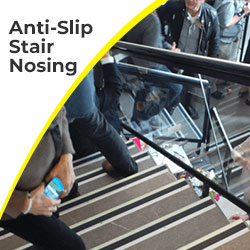









The installation of exquisite anti-slip stair nosing in an edifice is absolutely essential to ensure the health and safety of the denizens as well as to augment the pulchritude of the infrastructure. The authorities have implemented specific mandatory regulations like the Accessibility for Ontarians with Disabilities Act or AODA since 2005 to guarantee that the proprietors and contractors oblige to the rules while erecting any building. One of the most effective ways to conform to these regulations is to utilize the sublime Code-Compliant Stair Edge Nosing Solutions while designing the architecture.
Within the lofty skyscrapers, the stairways act as one of the most pivotal safety aspects that enables the occupants to exit securely in any circumstance. Stairway safety is crucial for emergency egress, and anti-slip stair nosings are essential in maximizing the safety of all the stairways in numerous ways.
The venerable Chapter 10 of the International Building Code encompasses all the means of egress within a building and dedicates a special section for stair nosings. Section 1011 explicitly specifies the regulations for stair nosings. The prerequisites outlined in the IBC ensure that the stair nosings within a facility are uniform and installed securely. To mitigate the tripping hazards, the stair nosings must not protrude more than 11⁄4 inch or 32 mm from the stair tread. Also, the stair nosings in any stairwell are required to be uniform to boost safety.
The anti-slip stair nosings can improve safety within a facility in various ways. Firstly, the stair nosings provide a non-slip grip to reduce the risk of slips and trips, irrespective of the conditions. Moreover, the stair nosings provide a stark color contrast against the stair. This color contrast enables increased visibility of the step-edge for all the occupants.
Many stair nosings feature a photoluminescent strip. This photoluminescent strip increases the color contrast between the step-edge and the substrate and provides excellent visibility of the step-edge in all lighting conditions. The photoluminescent stair nosings shall be applied according to section 1011 of the International Building Code and provide a brightly lit stairway even after the power failure in the facility. The luminescent light does not create shadows and glows brightly so that even in emergency conditions, the occupants can easily navigate the stairways safely.
When pondering how people ascend or descend a flight of stairs or observing others doing the same, one would notice that most of us step right onto the edge of the stair. As a result, this is the first part of the stair to exhibit signs of wear and tear. The signs of wear and tear can make a facility appear outdated and unmaintained, hampering the aesthetics of the building. Some people may even question the stairway’s safety if all the stairs appear battered.
The stair nosings are an excellent way to not only protect the steps from wear and tear but also to maintain the beauty of the facility. The stair nosings are applied where most people commonly step, the step-edge, to protect the stairs from the heaviest wear and tear. The carpet stair nosings prevent rips and tears in the carpet, which can pose a safety risk and make the building look old and run down. The solid stair nosings help to avoid any marks or chips on the stair. The sleek stair nosing helps to modernize the appearance of the building and protects the step edges in the facility from unsightly wear and tear.
Without the utilization of stair nosings, one may have to renovate, remodel or even redo the stairways over time, especially in buildings with heavy foot traffic. Safeguarding the investment from the outset is a cost-effective way to ensure that the stairways continue to remain safe without maintenance. The Ecoglo anti-slip stair nosings are sturdy enough to withstand even the heaviest foot traffic without exhibiting signs of wear and tear.
With the use of stair nosings, one can increase the lifespan of the stairways in the facility by protecting the step-edge and enhancing the safety of the occupants and residents. Although occasionally an afterthought, for anyone aspiring to upgrade the safety in their facility while improving the appearance, the stair nosings should be the most obvious choice!
At Tactile Solution Canada, we offer photoluminescent and non-photoluminescent Ecoglo stair nosings that can be “glued” or "screwed” to the existing surface and are incredibly durable and have been tested to withstand even the heaviest foot traffic. Each stair nosings features a non-slip grip to prevent injury and promote safety in the building.
Prioritize the stairway safety in your facility by contacting Tactile Solution Canada today!
